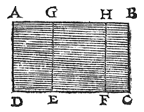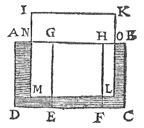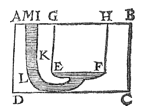T H E O R E M V I 1 1.
 Weight on EF = gravity of water GHFE. |
[ *) Translation from Principal Works, vol. I, p. 415; Introd. p. 377.]
Supposition.
 Let ABCD be a water, whose form be a corporeal rectangle, whose upper surface be AB and a bottom therein EF, parallel to the horizon.
Let ABCD be a water, whose form be a corporeal rectangle, whose upper surface be AB and a bottom therein EF, parallel to the horizon. Let also GE be the vertical from the plane through the water's upper surface to the bottom EF,
and the prism comprehended by the bottom EF and the height EG shall be GHFE.
What is required to prove.
We have to prove that on the bottom EF there rests a weight equal to the gravity of the water of the prism GHFE.
Proof.
 If there rests on the bottom EF more weight than that of the water GHFE, this will have to be due to the water beside it.
If there rests on the bottom EF more weight than that of the water GHFE, this will have to be due to the water beside it. Let this, if it were possible, be due to the water AGED and HBCF.
But this being assumed, there will also rest on the bottom DE, owing to the water GHFE, because the reason is the same, more weight than that of the water AGED; and on the bottom FC also more weight than that of the water HBCF;
and consequently on the entire bottom DC there will rest more weight than that of the whole water ABCD, which (in view of ABCD being a corporeal rectangle) would be absurd.
In the same way it can also be shown that on the bottom EF there does not rest less than the water GHFE.
Therefore, on it there necessarily rests a weight equal to the gravity of the water of the prism GHFE.
Corollary I.
 Weight of IKLM = weight of water column NOLM (Archimedes' principle). |
This being so, the solid body IKLM is of equal weight to the water having the same volume as NOLM, by the 5th proposition, owing to which the body IKLM, with the remainder of the water surrounding it, is of equal weight to a body of water having the same volume as ABCD.
Therefore we still say, according to the proposition:
| against the bottom EF there rests a weight equal to the gravity of the water having the same volume as the prism whose base is EF and whose height is the vertical GE, from the plane AB through the water's upper surface AN to the base EF. |

 This being so, the water below the bottom EF exerts the same thrust against EF, i.e. against the solid body, as it did before against the water.
This being so, the water below the bottom EF exerts the same thrust against EF, i.e. against the solid body, as it did before against the water. 